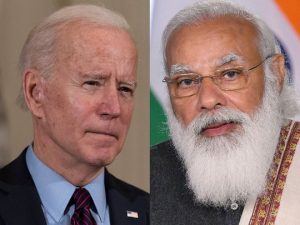
- A month and a week into power Joe Biden’s US government is still grappling with domestic issues
- The world expects him to look beyond the borders
By Commodore Anil Jai Singh, IN (Retd)
New Delhi. 28 February 2021. The defining feature of President Joe Biden’s foreign policy has been the USA’s return to multilateralism and his deep commitment to tackling climate change. He had underlined these as his foremost priorities during his election campaign and reiterated this intent after winning the election in November 2020. Hence, one of his first actions on assuming office was to rejoin the World Health Organisation and the Paris Agreement on Climate Change from which his predecessor had walked out in a fit of pique. It is indeed ironic that, as the leading member of the United Nations Security Council responsible for ensuring a secure and peaceful world order, the US had chosen to abandon its commitment to the most severe long and short term crises facing the world ; while climate change threatens the very sustenance of humankind, the latter is the most severe health challenge in the last 100 years and both have the potential to impact global security.
At the recent G-7 Finance Minister’s meeting, the US Treasury Secretary, Janet Yellen reaffirmed this commitment to multilateralism which will be the recurring theme in the preparatory ministerial meetings on issues of global concern leading up to the G7 Leaders Summit to be held in the UK from 11-13 June 2021 for which Prime Minister Modi has also been invited by the British Prime Minister Boris Johnson.
It is heartening that the USA, as the world’s leading economic, technological and military power is reclaiming its status as the global leader committed to making the world a better place to live in. This will obviously cause some discomfiture amongst those who had believed that those days were in the past when the USA turned inwards with its ill -conceived ‘America First’ policy. The US Security Strategy of 2017 had clearly identified these ‘revisionist’ powers and the former Secretary of State Mike Pompeo’s statement in July 2020 had been stridently critical of China’s conduct and belligerence in the South China Sea and the Indo-Pacific.
The Indo-Pacific.
In the Indo-Pacific, China’s continuing belligerence and its attempts to reorient the existing international rules-based order into one with ‘Chinese characteristics’ has led even Eurocentric nations like Germany and the Netherlands and peripheral Indian Ocean powers like France to articulate their strategies in support of a Free and Open Indo-Pacific for the safe passage of goods and services which is critical to keep the wheels of commerce rolling in this globalised and trade dependent world. The USA will have to continue to accord this region the high priority that began with the ‘pivot’ in President Obama’s presidency when Mr Biden was the Vice President though the ‘rebalance’ that followed failed to rein in China and is considered by many to be one of the major foreign policy failures of that administration. China has continued with its aggressive posture towards the US presence in the South China Sea which was met with a similar response from the USA in the form of Carrier battle Group deployments and Freedom of Navigation Operations (FONOPS) which were anathema to the Chinese. Given China’s clear articulation of its intent to replace the USA as the global supremo, it leaves the Biden administration with very little room for manoeuvre. Hence, while the exchange of words may become less aggressive in tone and tenor, the essence will continue to remain the same.
At the recent meeting of the Foreign Ministers of the Quad countries ( Australia, Japan, India and the USA) which took place via a conference call on 18 February, many of the issues that were touched upon were a reiteration of those that had been discussed during the previous meeting held in Tokyo on 06 October 2020. These included the response to the pandemic, the need for resilient supply chains, the importance of a Free and Open Indo-Pacific, ASEAN centrality, the need to settle disputes through the process of law etc., among others. This time it was only Japan that made a direct mention of China. The fresh issue was the concern over the developments in Myanmar which figured in the statements released by all the four countries amid the hope of an early return to the democratic process.
Myanmar is of special concern to India. India has enhanced its engagement with Myanmar in recent years as part of its efforts to secure the Bay of Bengal region, reduce Chinese influence and build South Asian connectivity with South East Asia. In addition to the maritime concerns, China’s covert support to insurgent groups operating in India through its Myanmar proxies seriously undermines India’s and security in its politically sensitive North-Eastern region.
The Bilateral Relationship.
The US-India bilateral relationship is set to become an important factor in shaping the geopolitics not only of the Indo-Pacific region but also the contours of the future world order. As the Vice President, Joe Biden had described the Indo-US relationship as the defining partnership of the 21st century. In their first telephonic conversation on 08 February 2021, less than 20 days after he assumed office, President Biden and Prime Minister Narendra Modi discussed a range of contemporary issues including cooperation in tackling the covid epidemic, the importance of climate change, the importance of strengthening the Quad and adding further depth to the bilateral relationship.
In the four years of the Trump presidency, the Indo-US relationship maintained its upward trajectory since it was mutually beneficial for both. The 2+2 Ministerial Dialogue became a regular feature and there was forward movement on initiatives like the DTTI. India’s regional domain awareness, specially in the maritime domain got a considerable boost with the signing of the four foundational agreement which includes logistic support , information and intelligence sharing and communication interoperability amongst others. The military hardware imported from the US filled a critical deficit in the IAF’s strategic airlift capacity (the C-17, C-130 and the Chinook) , the Indian Navy’s long range maritime patrol capability (Boeing P8I aircraft) and the Army’s offensive firepower(Apache). For the USA, a friendly India is an effective counter balance to China and the USA will expect India to take up the slack in the Indian Ocean once China makes its move to dominate this space. USA is in the enviable position of being the prime supplier of expensive military equipment to the world’s largest arms importer under an arrangement that more or less eliminates the critical element of price negotiations to a government that is otherwise so price sensitive that it is often willing to even compromise capability for price. Any suggested arms sale to India therefore rarely faces any objection from the US legislative process for obvious reasons.
The depth of the US-India relationship during President Trump’s presidency with its ’Howdy Modi’ and ‘Namaste Trump’ brand of bilateral engagement did not however prevent President Trump from reminding India periodically that the relationship had its limits and US national interest was supreme. There was some friction on the issue of trade and tariffs with Harley Davidson, the symbol of American machismo, becoming a bone of contention despite the fact that its sales were so insignificant in the large Indian two-wheeler market that the company stopped producing the motorcycle in India. During the initial months of the covid pandemic , there was also an ‘or else’ moment over supply of the HCQS tablet to the USA. The issue of H1 B Visas which, although not a bilateral issue but impacted Indians the most, was under threat throughout the four years despite the Indian government frequently expressing its concern.
India had to buckle to US pressure and cease buying oil from Iran under threat of sanctions which had an adverse effect on India’s traditional friendly relationship with Iran and its efforts at strategic capacity enhancement through building better connectivity and influence in that region. China, ever willing to fill any such power vacuum was prompt in making its move in the region. This has serious security implications for India which is heavily dependent on its crude oil supplies from the Arabian Gulf and its tankers have to transit through the narrow Straits of Hormuz and then pass the Chinese controlled Pakistani port of Gwadar. Similarly, the threat of CAATSA sanctions over the purchase of the S-400 system from Russia remains unresolved. This hardly reflects well on the ‘strategic’ depth of the relationship between equals. Hopefully the new administration will respect India’s policy of ‘strategic autonomy’ and work towards ironing out some of the wrinkles that appear from time to time in this relationship.
The USA’s return to multilateralism, inclusive capacity building and combating climate change augurs well for the Indo-US bilateral relationship. India has been active in its multilateral engagement, both at the regional as well as global level. In the Indo-Pacific region itself, the US led Blue Dot network and India led Indo-Pacific Oceans Initiative are just two instances where US – India convergence can benefit the region as a whole. Similarly, initiatives on tackling the covid pandemic and in the longer term, the challenge of climate change can be further energised by this relationship . India is working sincerely towards meeting the self-regulated targets listed in the Agenda 30. India and the USA must work together in developing sources of clean energy , alternatives to fossil fuels and harnessing the potential of the Blue Economy for responsible exploitation of the oceans for sustainable development.
The USA has repeatedly committed its support for India’s inclusion as a Permanent member of the Security Council as have all the other members of the Security Council except for China. While India’s case by itself is unlikely to get any special consideration, there is a strong case for the expansion of the Security Council. As a non- permanent member of the UN Security Council in 2021-22 and its global acceptance as a stabilising force for good, India is in a position to push for this long overdue reform in the United Nations to align with the contemporary global realities. The USA’s support would make a big difference. In 2022, India will be taking over the Presidentship of the G20, an influential body comprising the 20 biggest economies of the world. In keeping with its support to multilateralism, the USA’s support for driving the G20 agenda will enable India to derive positive outcomes.
In his 100 day agenda as reported in the media, President Biden’s focus is on the domestic issues that need urgent attention. Hence it may be too premature to comment on the future of the Indo-US relationship. However, there is every indication that the upward momentum of this relationship will continue. It has the potential to not only ‘define’ the future of the Indo-Pacific but also influence the global balance of power in the years to come.
The author Commodore AJ Singh is an ex-submariner of the Indian Navy and a defence expert. He is the Vice President at Indian Maritime Foundation. The views in the article are solely the author’s. He can be contacted at editor.adu@gmail.com

























































































































